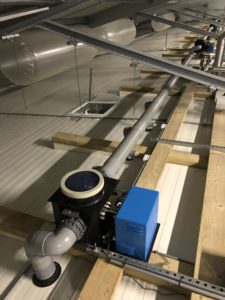Loss of moisture during storage is an important parameter that partly determines the storage time and quality of vegetables and fruit. In some cases it is, therefore, desirable to actively prevent moisture loss. For many fresh products, and certainly for pome fruit, moisture that has been lost cannot be reintroduced. So, what remains is indeed the prevention of moisture loss, but how do you accomplish that?
Controlled Atmosphere cold stores are gastight. After closing the door, the relative humidity (RH) will increase. With apples, pears and kiwis, the relative humidity usually rises to 95-98%. After that, the fruit can hardly lose moisture: there is no ‘space’ for it. This changes when there is a cooling action and when some of the water in the air freezes on the evaporator. This causes a dip in the RH, and this ‘gap’ is then refilled by loss of moisture from the fruit.

In the first instance, it is therefore important to apply a cooling system that removes as little water as possible from a cold store by freezing. The total evaporation surface (lamella surface) and the temperature difference that is used plays a role in this. In short, a cooling system with small evaporators and a high delta T may often be cheap, but in the end it usually turns out expensive. Just one percent more moisture loss in a 200 ton cell can already lead to € 1,000.= – € 2,000.= in annual loss of income due to weight loss alone. Loss of quality is not included in this.
Moisture loss can be prevented by humidifying during the RH dip, but this does not always happen effectively. Spraying water is generally pointless, because the water dissolves too slowly in the air of the cold store. Nozzles are better, but usually still not effective enough. In the case of products that are stored just below 0 °C (such as pears), this type of humidification can lead to a lot of ice formation. This results in inefficient cooling and damage to the stored product. The only really correct solution is ultrasonic humidification. These humidifiers produce a cloud of very small water droplets of 0.5-2.0 µm that immediately dissolve in the cell air. For that reason it is also called ‘cold steam’. These humidification units are usually switched on during a cooling action, or based on measured RH values.
The special thing about the humidification units that Blue Atmosphere produces and sells is that they do not have their own control and therefore do not work standalone. They are operated by the cold cell controllers of the Blue Atmosphere control system. This has a number of advantages. For example, it is possible to determine very precisely how much moisture is introduced into a cold store (just as it can be measured how much water a cold store loses: water meters). Because the humidification is integrated, the control and logging are included in our Scada user interface. This way you keep an exact overview of the water balance in a cold store.